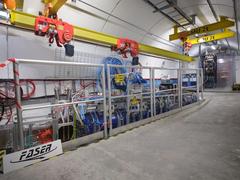URL: https://www.desy.de/news/news_search/index_eng.html
Breadcrumb Navigation
DESY News: Research team detects first neutrinos made by a particle collider
News
News from the DESY research centre
Research team detects first neutrinos made by a particle collider
An international research team at the FASER experiment at the Large Hadron Collider LHC in Geneva has for the first time detected subatomic particles called neutrinos created by a particle collider. The discovery promises to deepen scientists’ understanding of the nature of neutrinos, first spotted in 1956, which are the most abundant particle in the cosmos and a key participant in the process that makes stars burn. The results of the measurement were announced in a presentation on behalf of the FASER Collaboration on Sunday at the 57th Rencontres de Moriond Electroweak and Unified Theories conference in Italy. The first observation of neutrinos at a collider marks the beginning of physics with collider neutrinos, and allows scientists to investigate phenomena that have been inaccessible until now.

The FASER detector is located deep underground in a side tunnel at the LHC near the ATLAS detector. Photo: CERN
The experiment FASER (Forward Search Experiment) is a particle detector designed and built by an international group of physicists and installed at the LHC at CERN. There, FASER detects particles that are produced by the LHC. “Neutrinos have been known for several decades, and were very important for establishing the standard model of particle physics. But previously, no neutrino produced at a collider had ever been detected by an experiment, and even today the larger experiments at the LHC are unable to directly detect, so FASER’s successful observation means the collider’s full physics potential can finally being exploited,” says DESY theorist Felix Kling, one of the three others who proposed the FASER experiment together with Feng in 2018. For Kling who conducted the simulations of how many neutrinos one could expect from the FASER experiments, this is only the start for a new era: he is co-leading the “Forward Physics Facility” project. “In this project we want to continue this neutrino programme at the High-Luminosity LHC with larger detectors and then detect millions of neutrinos,” says Kling.
FASER itself is brand-new and unique among particle-detecting experiments. Compared to other detectors at CERN like ATLAS or CMS, which are several stories tall and weigh thousands of tons, FASER is only about one ton and fits neatly into a small side-tunnel at CERN. For that, it took only a few years to design and construct it, using spare parts from other experiments. The neutrinos detected by FASER are the highest energy ever produced in a lab. Together with astroparticle experiments like IceCube or CTA, which are measuring neutrinos of a wide energy range showering on the earth from deep-space, FASER will help to further understand the role of these mystic particles.
Beyond neutrinos, one of FASER’s other chief objectives is to help identify the particles that make up dark matter, which physicists think comprises most of the matter in the universe, but which they’ve never directly observed before.
Further Information
Website of the FASER experiment



